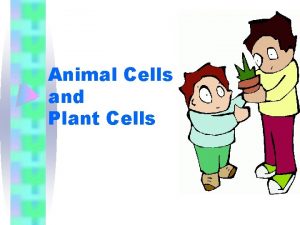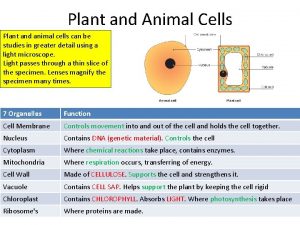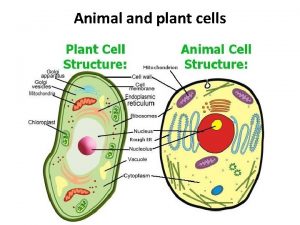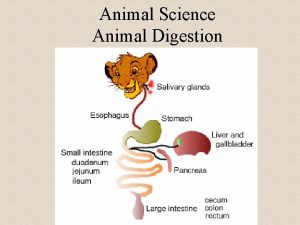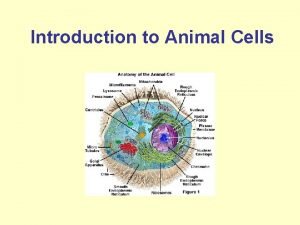1 3 a Animal cells LO Locate and














- Slides: 14

1. 3 a Animal cells • LO: Locate and describe the structure of an animal cell. Starter: Animal cells Can you spell the following words CORRECTLY in the back of your book? Nucleas, cytopllasm, clorroplasts, sell, vacoule. Plant or animal? What are the similarities and differences between an animal and plant cell? Cell Animal Plant Similarities Differences

1. 3 a Animal cells • LO: Locate and describe the structure of an animal cell. Arm Stage Focussing wheel Base Eyepiece Objective lens Slide Mirror

Learning outcomes (activity 1) • Label the structures found in a animal cell Low • Describe the function of each organelle. Mid High GCSE • Create an acronym to help you to remember the organelles found in animal cells. • Write the word equation for respiration, a process that occurs in the Mitochondria. Key Words – cytoplasm, mitochondria, cell membrane, nucleus, respiration

Animal cells research q q Highlight animal cell parts in pink Highlight plant cell parts in green Highlight functions in blue Label the diagrams above q Draw and label an animal cell q Describe the function of each organelle: cytoplasm, nucleus, cell membrane and mitochondria q Draw a cheek cell and describe how it functions q Create an acronym to help you to remember the organelles found in animal cells. Low Mid • Label the structures found in a animal cell • Describe the function of each organelle. High • Create an acronym to help you to remember the organelles found in animal cells. GCSE • Write the word equation for respiration, a process that occurs in the Mitochondria. Key Words - cytoplasm, mitochondria, cell membrane, nucleus, respiration

1. 3 a Animal cells • LO: Locate and describe the structure of an animal cell. Nucleus Cytoplasm Cell membrane Mitochondria

Learning outcomes (activity 2) Low Mid High GCSE • Draw a scientific diagram of a group of cheek cells and label the main structures seen. • Calculate total magnification of the cheek cells you are viewing. • Calculate the actual size of a cheek cell from a micrograph. • Demonstrate complete competence when producing a stained slide of a cheek cell Key Words – cytoplasm, mitochondria, cell membrane, nucleus, respiration

Viewing animal cells - method • LO: Locate and describe the structure of an animal cell.

Viewing animal cells ü Draw a group of cells ü Use a sharp pencil ü Don’t colour/shade in any parts of the drawing ü Give your drawing a heading ü Draw the specimen in a rectangle not a circle ü Label each structure Low ü Calculate total magnification of the cheek cell High ü find the actual size of a cell measured under a microscope. The cell is 1 cm in diameter Cells x 1000 • Draw a scientific diagram of a group of cheek cells and label the main structures seen. • Calculate total magnification of the cheek cells you are viewing. Mid • Calculate the actual size of a cheek cell from a micrograph. GCSE • Demonstrate complete competence when producing a stained slide of a cheek cell Key Words - cytoplasm, mitochondria, cell membrane, nucleus, respiration

Learning outcomes (activity 3) • Classify the euglena as a plant or animal. Low Mid • Describe some similarities and differences between a plant and animal cell. • Discuss the merits of the euglena being an animal cell. High GCSE • State some issues when dealing with the classification of different organisms giving an example. Key Words – cytoplasm, mitochondria, cell membrane, nucleus, respiration

1. 3 a Animal cells • LO: Locate and describe the structure of an animal cell. Scientists discovered a cell many years ago that they called Euglena Some scientists thought that Euglena was a plant cell Other scientists thought that Euglena was an animal cell Your next task will be to decide what YOU would class it as Euglena http: //www. youtube. com/watch? v=s. Yu p. CQT 46 c. I

Euglena – animal or plant? • Classify the euglena as a plant or animal. Low Mid Similarities with an animal cell Differences with an animal cell • Describe some similarities and differences between a plant and animal cell. • Discuss the merits of the euglena being an animal cell. High GCSE • State some issues when dealing with the classification of different organisms giving an example. Key Words - cytoplasm, mitochondria, cell membrane, nucleus, respiration

1. 3 a Animal cells • LO: Locate and describe the structure of an animal cell. Arm Stage Focussing wheel Base Eyepiece Objective lens Slide Mirror

1. 3 a Animal cells • LO: Locate and describe the structure of an animal cell. ? ?

Learning outcomes • LO: Locate and describe the structure of an animal cell. • Label an animal cell correctly. Low Mid • Describe the functions of the nucleus, cell membrane, mitochondria and cytoplasm, . High • Compare and contrast the similarities and differences between a animal cell and euglena. GCSE • Write the word equation for respiration, a process that occurs in the Mitochondria. 1. Which outcome are you most confident with? 2. What Band do you believe you confidently achieved today? 3. What outcome would you like to improve your knowledge on?
 Animal rights and animal welfare venn diagram
Animal rights and animal welfare venn diagram Paranasal sinuses development
Paranasal sinuses development Chlorocruorin
Chlorocruorin Masses of cells form and steal nutrients from healthy cells
Masses of cells form and steal nutrients from healthy cells Principal cells vs intercalated cells
Principal cells vs intercalated cells Parafollicular cells vs follicular cells
Parafollicular cells vs follicular cells Gamete vs somatic cell
Gamete vs somatic cell Somatic cells vs germ cells
Somatic cells vs germ cells Prokaryote vs eukaryote cells
Prokaryote vs eukaryote cells Prokaryotic cells
Prokaryotic cells The organelle trail
The organelle trail Younger cells cuboidal older cells flattened
Younger cells cuboidal older cells flattened What cell type
What cell type Staphylococcus aureus prokaryotic or eukaryotic
Staphylococcus aureus prokaryotic or eukaryotic Chapter 8 cellular reproduction cells from cells
Chapter 8 cellular reproduction cells from cells















